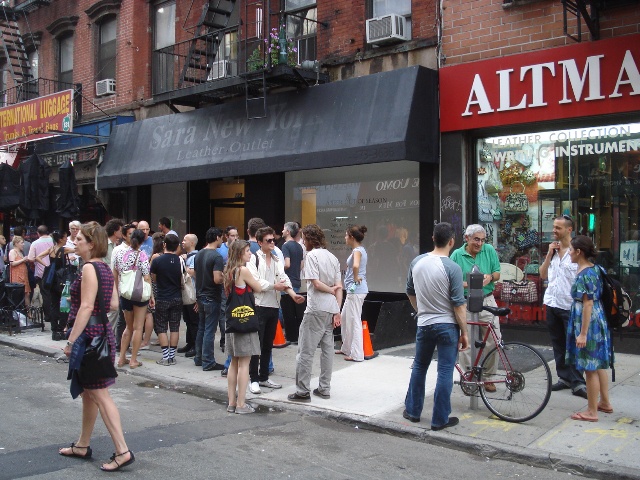
Orchard Street, site of occasional crowds, in 2013. Image courtesy Art in America.
Over the course of the last ten years, the Lower East Side has transformed from an immigrant working-class neighborhood to a home for boutique enterprises. This is not new. But the Lower East Side, particularly on Orchard Street, appears to be undergoing shifts that might provide some clues to understanding what the LES might look like in the years to come. South Orchard remains a pleasant place to work during the daytime, for art dealers in particular, but those who live there or operate at night, have more to fear from a nightlife-heavy crowd.
To state the obvious, Orchard Street already has the feel of “Soho-lite.” That is, what it was like some 30-odd years ago: boutiques, galleries, shiny cobblestone streets, and artists. Just look at the pristine cobblestone streets. The shiny cobblestones on the two-block strip of Orchard below the Tenement Museum were installed in the 1990s by Sion Misrahi, a local developer who hoped to scrub out the grit of the Lower East Side and transform it into a Disneyfied historic district.
Then, in 2007, Misrahi told the New York Times he had changed course.
“We decided to rent to bars and restaurants,” said Misrahi, “who would bring in the hipsters and change the neighborhood.”
Choosing hipsters over history has not fared well with community activists. Diem Boyd, a longtime member of LES Dwellers, a group focused on curbing liquor licenses, told me: “Turning neighborhood after neighborhood into homogenized ‘Bourbon Streets’ catering to weekend transients from the suburbs strips the city of its historically rich and diverse cultural and artistic capital.”
Gallery tenants, in comparison, expressed that the LES has yet to turn into a boozy playground.
“I live and breathe this Jewish ghetto,” UNTITLED’s Joel Meisler told me. He lives just two blocks away; he and the gallery plan on staying. The gallery has a long-term lease; they also happen to have some of the highest ceilings on the block.
“Sammy the suit salesman is still here,” Meisler said.
It’s like Soho in the 1970s and 1980s, for some Orchard Street dealers, who expressed that the neighborhood is one of the few places where walk-ins, unfamiliar with the gallery will purchase art.
It’s not just random foot traffic, though, that guides the current crop of dealers in the area; there’s a different type of collector who follows the Orchard Street path.
“It’s an easy go-to,” said Michael Foley, of Foley Gallery, referring to the art crowd. “The street has become nearly synonymous with the Lower East Side gallery scene.”
His previous location, at Allen and Broome, was away from the well-trodden path of LES visitors and gallery goers. Moving to 59 Orchard Street has solved that problem.
Still, condo dwellers in the Lower East Side help contribute to that foot traffic. Those visitors might not be expert in the language of art collecting, but they are receptive to it. I spoke with one Bond Properties broker who has spent close to a decade showing and selling million-dollar condos at 50 Orchard Street. In all her years of working the condo circuit, she has never had a client who was an avid art collector, dealer, or artist.
“However, they definitely like and participate in the cultural ‘vibe’ of being near galleries,” she commented over email.
While foot traffic continues to be strong, and with an art-inclined audience, all tenants seem wary of the neighborhood becoming too boozy. They’ve seen it happen in “Hell Square,” a stretch of nine blocks between East Houston and Delancey Streets and Allen and Essex Streets, with over 35 bars. Art galleries maintain daytime hours, excluding openings, making it harder to gauge the effects of nightlife on residents.
Tuan Bui, co-owner of the Vietnamese restaurant An Choi at 85 Orchard, lives down the street from his place of business. He’s apprehensive about the encroachment of nightlife, but sees how his neighboring tenants appreciate having “diversity in the mix: laundromats, people, and bars.” As for art dealers, Bui could not say who they were by name. “I know them more by faces,” Bui told me. “But I think the restaurants and bars have more of a support network.”
The most anticipated change to lower Orchard, for all tenants, will be the arrival of a new 105-room hotel at 54 Canal, home to the landmark Jarmulowsky Bank building. The luxury establishment has been slated for a late 2015 open, but that seems unlikely given the sluggish renovation project. In October 2014, Bowery Boogie reported that the New York Department of Buildings issued a stop-work order after scaffolding broke loose from the building’s exterior, landing on adjacent property.
Though the hotel’s future remains unknown, the rest of the real-estate market continues to swell with higher rents. The best marker for where the Lower East Side stands in comparison to Soho lies with the numbers: According to the 2014 MNS Manhattan Rental Market Report, the average rental price in Soho increased by 10.1 percent from 2013. In comparison, the Lower East Side experienced a 6 percent increase. Overall, rental prices in Manhattan went up by approximately .29 percent. Rents still swing upward in the LES, but they have not caught up with Soho—yet.


Comments on this entry are closed.